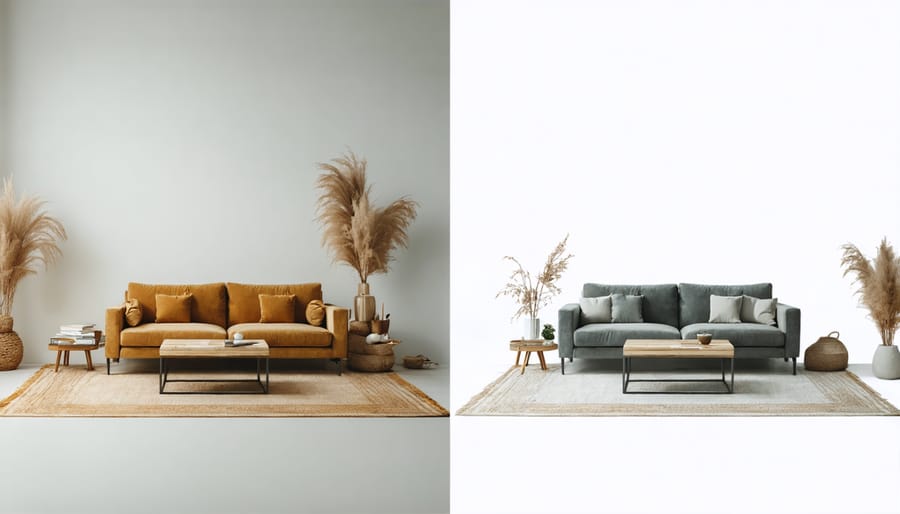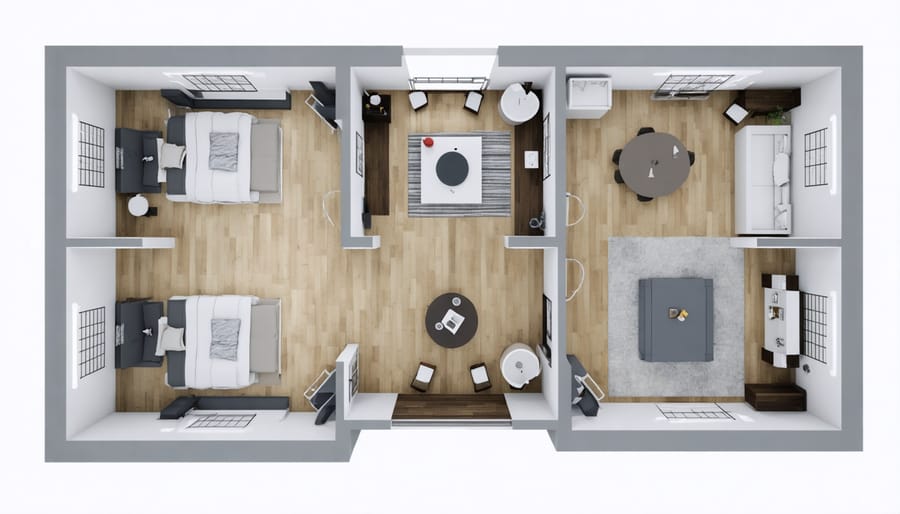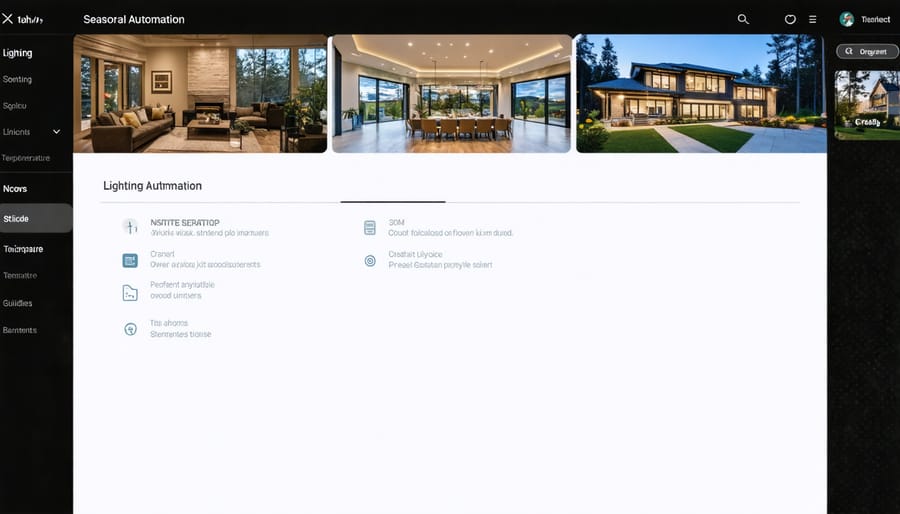
Make Your Home Flow with the Seasons: Smart Adaptive Floor Plans That Work Year-Round
Transform your living space effortlessly throughout the year with adaptive house plans that evolve with each season. Open-concept layouts with movable partitions create flexible zones that adapt to both summer entertaining and cozy winter gatherings. Smart furniture placement near windows maximizes natural light in winter while enabling cross-ventilation during summer months, seamlessly integrating seasonal home styling with practical functionality. Multi-purpose rooms equipped with modular furniture and built-in storage solutions transform living spaces from bright, airy summer retreats to intimate winter havens without major renovations. Modern smart home technology automates these transitions through programmable lighting, climate control, and motorized window treatments, making seasonal adaptations effortless and energy-efficient.
Why Your Home Needs to Adapt with the Seasons
Seasonal Living Patterns
Just as nature transitions through the seasons, our living patterns naturally shift throughout the year. During winter months, families tend to gather more in cozy indoor spaces, particularly around the living room and kitchen areas. This often calls for furniture arrangements that promote intimate conversation and warmth, with seating grouped closer together and additional soft lighting options.
Summer brings a different dynamic, with more time spent in outdoor spaces and open-concept areas. Furniture might be repositioned to create clear pathways to patios and decks, while indoor-outdoor flow becomes a priority. Spring and fall are transitional periods where flexibility is key – think moveable partition walls and modular furniture that can be easily rearranged.
Many families also adjust their home office and study spaces seasonally. During school months, dedicated workspace arrangements take precedence, while summer might see these areas transformed into entertainment zones or guest rooms. Smart storage solutions and multi-purpose furniture become essential for these seasonal transitions, allowing spaces to evolve naturally with your family’s changing needs throughout the year.
Climate Considerations
Weather patterns significantly impact how we use our homes throughout the year. During summer months, spaces like patios and sunrooms become natural extensions of living areas, while winter drives activities indoors. Smart adaptive house plans consider these seasonal shifts, incorporating features like retractable awnings, adjustable window treatments, and versatile room layouts that can be modified based on weather conditions.
Temperature fluctuations also influence room usage patterns. South-facing rooms might be perfect for winter activities but too warm in summer, while basement spaces offer cool refuge during heat waves. Consider creating zones that can serve different purposes as needed – a screened porch that transforms into a cozy winter reading nook with the addition of temporary insulation panels, or a garage that doubles as a summer workshop when temperatures permit.
Modern climate control solutions, including smart thermostats and zoned HVAC systems, help maintain comfort while maximizing energy efficiency. Including adequate insulation and weather-responsive features in your house plan ensures your home remains comfortable and functional year-round, regardless of external conditions.
Core Elements of an Adaptive Floor Plan

Flexible Furniture Arrangements
Adapting your furniture layout throughout the year can dramatically transform your living space to match seasonal needs. By implementing flexible furniture solutions, you can create spaces that work seamlessly across all seasons.
During summer months, arrange seating to maximize airflow and create clear pathways to windows and outdoor access points. Consider positioning sofas and chairs away from direct sunlight to maintain comfortable temperatures. Lightweight, mobile pieces like ottoman poufs and folding side tables can be easily relocated to create impromptu outdoor entertaining areas.
Winter arrangements typically focus on creating cozy gathering spaces around heat sources. Pull seating closer together to encourage conversation and warmth sharing. Consider using area rugs to define these intimate spaces while adding extra insulation to your floors.
Spring and fall are perfect times to experiment with transitional layouts. Use modular furniture pieces that can be separated or combined as needed. Multi-functional pieces like storage ottomans and expandable dining tables help maximize space efficiency while adapting to changing entertainment needs.
Keep furniture on casters or sliders for easy movement, and invest in pieces that can serve multiple purposes throughout the year. Remember to maintain clear pathways regardless of the season, ensuring at least 36 inches of walking space in high-traffic areas.
Multi-Purpose Spaces
Modern living demands flexibility, and multi-purpose spaces are the perfect solution for adapting your home to different needs throughout the year. Think of a home office that transforms into a guest room during holiday visits, or a sunroom that serves as both a cozy winter reading nook and a summer entertainment space.
The key to creating successful multi-purpose spaces lies in smart furniture choices and modular design elements. Consider investing in fold-down desks, Murphy beds, or modular seating that can be easily rearranged. Storage solutions play a crucial role too – ottoman benches with hidden storage, rolling cabinets, and collapsible tables help maintain organization while maximizing functionality.
Seasonal transitions become seamless with thoughtful zoning. Use area rugs, movable screens, or lightweight room dividers to define different activity areas within the same space. For example, a large living room can feature a workout zone in the morning, a workspace during the day, and a family gathering area in the evening.
Lighting also plays a vital role in transforming spaces. Install adjustable lighting systems with different settings for various activities – bright for workspaces, warm for entertainment, and dim for relaxation. Smart home technology can help automate these transitions, making it easier to switch between different room functions with minimal effort.
Remember to keep the space’s core purpose in mind while planning secondary functions. This ensures that quick transitions between uses remain practical and stress-free.

Seasonal Transition Techniques
Spring/Summer Adaptations
When temperatures rise, your home can adapt to create a cooler, more comfortable living environment. Start by rearranging furniture to maximize natural airflow and create open pathways for cross-ventilation. Position seating areas away from direct sunlight and consider implementing light-colored slip covers to reflect heat.
Transform your living spaces by switching to lightweight, breathable fabrics for curtains and upholstery. Install retractable awnings or solar screens on south and west-facing windows to reduce heat gain while maintaining views. Smart thermostats can be programmed to adjust cooling patterns based on daily routines, optimizing energy efficiency.
Create seamless indoor-outdoor transitions by incorporating sliding glass doors or French doors that open to patios and porches. This extension of living space allows for natural cooling and expands your usable area during pleasant weather. Consider installing ceiling fans in key rooms to improve air circulation and create a cooling effect without heavily relying on air conditioning.
In the bedroom, swap out heavy winter bedding for lightweight alternatives and position beds to catch evening breezes. Convert unused spaces like sunrooms or screened porches into seasonal living areas by adding comfortable seating and portable fans. Remember to adjust your lighting scheme, using LED bulbs that generate less heat and incorporating task lighting for specific activities rather than relying on heat-producing overhead fixtures.
Fall/Winter Modifications
As temperatures drop, implementing strategic cozy home adaptations becomes essential for maintaining comfort and energy efficiency. Start by repositioning furniture away from windows and exterior walls to minimize cold spots and create warmer seating areas. Consider installing thermal curtains or cellular shades that can be easily drawn during evening hours to retain heat.
Smart zoning strategies help maximize warmth in frequently used spaces while reducing heating costs in less-utilized areas. Install programmable thermostats in different zones to maintain optimal temperatures throughout your home. Weather stripping around windows and doors should be checked and replaced as needed to prevent drafts.
In open-concept spaces, use folding screens or mobile room dividers to section off areas, creating intimate spaces that retain heat more effectively. Add area rugs to bare floors, especially in seating areas, to provide insulation and comfort underfoot. Consider temporary modifications like draft stoppers under doors and window insulation film that can be easily removed when spring arrives.
For maximum comfort, create designated warm zones near heat sources, perfect for reading nooks or work areas. Remember to reverse ceiling fans to push warm air downward, and consider adding portable heating solutions in traditionally cooler spaces. These modifications not only enhance comfort but also contribute to energy efficiency during the colder months.
Storage Solutions
Efficient storage solutions are the backbone of any adaptive house plan, especially when managing seasonal items and furniture. Think of your home as a dynamic space that needs to accommodate everything from summer patio furniture to winter holiday decorations without feeling cluttered.
Start by implementing a zone-based storage system. Designate specific areas in your garage, attic, or basement for different seasons, and use clear, weatherproof containers with detailed labels. This makes seasonal transitions smoother and prevents damage to stored items.
Consider multi-functional furniture pieces that offer hidden storage compartments. Ottoman beds, hollow bench seating, and storage coffee tables can hide away seasonal items while serving daily purposes. For smaller homes, vacuum storage bags can compress bulky winter bedding and clothing to a fraction of their original size.
Vertical storage is often underutilized but incredibly valuable. Install adjustable shelving systems that can be reconfigured as your needs change. Wall-mounted racks and ceiling-mounted platforms in garages can store seasonal sporting equipment and outdoor furniture without sacrificing floor space.
For frequently rotated items like clothing, consider a capsule wardrobe system with modular closet organizers. This allows you to easily swap seasonal clothing while maintaining organization. Remember to keep frequently used items accessible and store rarely-used pieces in harder-to-reach spaces.
Finally, document your storage system with photos and inventory lists. This prevents the frustrating “where did I put that?” moment when seasons change and helps maintain organization year after year.
Smart Technology Integration
Automation Systems
Modern automation systems are revolutionizing how homes adapt to seasonal changes. At the heart of these innovations are smart lighting systems that automatically adjust brightness and color temperature to match natural daylight patterns throughout the year. Programmable thermostats learn your preferences and optimize heating and cooling based on seasonal weather patterns, while motorized blinds and shades can be scheduled to manage natural light and heat gain.
Voice-controlled hubs integrate these systems seamlessly, allowing you to create seasonal “scenes” that transform your space with a single command. For example, a “winter evening” setting might trigger warmer lighting, raise the temperature, and close the blinds, while a “summer morning” scene could gradually open blinds and activate cooling systems before you wake up.
Consider installing occupancy sensors that automatically adjust settings based on room usage, helping you save energy during less-active seasons. These smart solutions not only enhance comfort but also contribute to significant energy savings throughout the year.

Energy Efficiency
Modern adaptive homes leverage smart technology to maximize energy efficiency across seasons. Programmable thermostats and zoned heating systems allow for precise temperature control in different areas of your home, reducing energy waste in unused spaces. Smart windows with electrochromic glass automatically adjust their tint based on sunlight intensity, helping maintain optimal indoor temperatures naturally.
Automated external shading systems can deploy during peak summer hours to minimize heat gain, while retracting in winter to maximize solar warming. Smart ventilation systems work in harmony with natural airflow patterns, automatically adjusting based on outdoor conditions and indoor air quality needs.
Energy monitoring systems provide real-time feedback on consumption patterns, helping homeowners identify opportunities for improvement. These systems can be integrated with smart home hubs to automatically adjust settings based on occupancy, time of day, and weather conditions. Some advanced setups even incorporate machine learning to predict and adapt to your family’s routines, ensuring optimal comfort while minimizing energy use.
Consider installing a smart energy storage system that can store excess solar power for use during peak demand periods, further reducing your environmental impact and energy costs.
Embracing adaptive house plans is more than just a design choice – it’s an investment in your home’s versatility and your family’s comfort throughout the year. By implementing the strategies we’ve discussed, you can create a living space that effortlessly transitions with the seasons while maintaining both functionality and style.
Remember that successful adaptive planning starts with understanding your space’s potential. Whether you’re rearranging furniture for optimal seasonal flow, incorporating multi-purpose rooms, or integrating smart home technology, each modification contributes to a more flexible and enjoyable living environment.
Start small by implementing one or two changes, such as creating a modular furniture layout or installing programmable thermostats. As you become more comfortable with the concept, gradually incorporate additional adaptive elements that suit your lifestyle and budget. Don’t forget to consider your local climate and how it affects your home’s needs throughout the year.
The beauty of adaptive house plans lies in their ability to evolve with your changing needs. By making thoughtful modifications to your living space, you’ll not only enhance your daily comfort but also potentially increase your home’s value. Take the first step today in transforming your house into a dynamic, season-ready home that works for you year-round.
